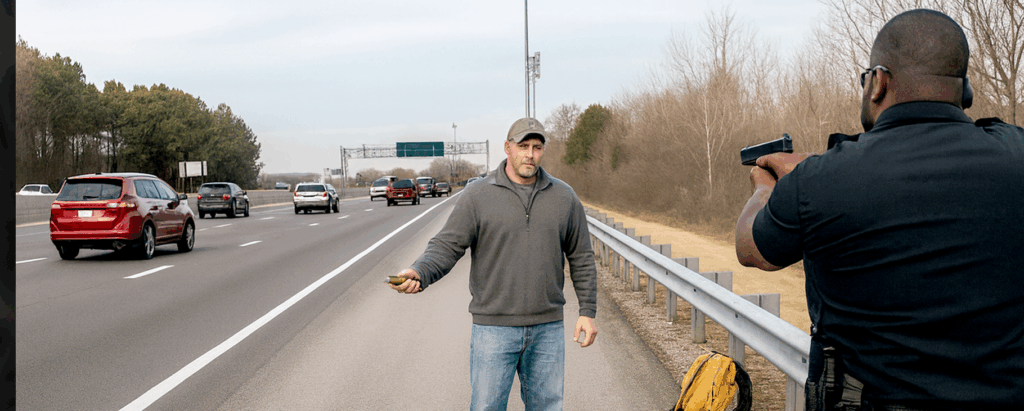United States v. Radaker-Carter, 2025 WL 2399352 (6th Cir. 2025)
At a store parking lot in Detroit, Michigan, a woman (identified in court documents as E.J.) was carjacked at gunpoint by two masked men. She had seen them in the store before the carjacking (wearing face masks in the waning months of the COVID-19 pandemic), noting one was light-skinned and the other dark-skinned. After the incident, while E.J. was waiting for police to arrive, another customer approached her and said she knew the light-skinned man from school. She gave the man’s name, Kyrrah Radaker-Carter, and later sent the investigating officer photos and information from his Facebook profile.
Officers asked the customer not to share photos of the accused carjacker with E.J., but the woman did so anyway. Before a photo lineup with police, E.J. confirmed to the customer that the man in the photo was the carjacker. The next day, E.J. participated in a six-photo lineup and immediately identified Radaker-Carter. Officers later arrested him while he was driving E.J.’s stolen car.
Radaker-Carter asked the trial court to suppress E.J.’s identification and the court denied his motion. The court ruled any suggestive circumstances related to the exchange between E.J. and the other customer were not created or condoned by police. The court also held the police photo array itself was not unduly suggestive. Radaker-Carter pleaded guilty and was sentenced to 10 years. He appealed the suppression ruling.
Eyewitness identification — whether obtained through a photographic lineup or the far-less-common live lineup — has traditionally carried a strong presumption of reliability. . We tend to rate our memories as very reliable. However, advances in science and scrutiny by courts have sharply questioned the validity of eyewitness identification procedures that do not follow scientific best practices. The American Psychological Association reports jurors in criminal trials tend to “over believe” eyewitness accounts, giving too much credit and not entertaining doubts that an eyewitness could be well-meaning and sincere, but still mistaken.
In a traditional photo lineup, the process is administered by an investigator involved in the case, who knows the identity of the suspect whose photo is mixed in with five other photos (known as “fillers”). Researchers and courts have focused on whether identification procedures should be “blindly” administered, and whether photographs should be presented simultaneously, as is traditionally done, or sequentially. In blind administration, the person administering the lineup is unaware of the suspect’s identity or placement in the photo array. If the person conducting the lineup knows which photo shows the presumed suspect, there is a significant risk of the administrator cuing the witness. (The cue may only be a facial tic or drawn breath.) Blind administration eliminates even unconscious cuing and reduces the likelihood of erroneous identification.
Some research suggests the simultaneous presentation method allows witnesses to make choices by comparing the lineup members to each other, resulting in them selecting the photo that most closely resembles the perpetrator — regardless of whether the perpetrator is present in the lineup. Police officers who have ever shown a simultaneous photo array using loose photos may have actually seen this occur when a witness slides a non-suspect photo off to one side to eliminate it from consideration or to narrow the field. When the actual perpetrator is absent from the lineup, witnesses may get to their selection by picking which photo looks more like the offender than the others, increasing the chance of misidentification. As a practical matter, there are other reasons the sequential presentation method can protect the purity of an identification procedure. Slight differences in the quality, composition, or backgrounds of filler photographs become more apparent when the photographs are laid side by side.
Lexipol’s Eyewitness Identification Policy emphasizes best practices such as the following:
- Blind administration: Ensure the person presenting the photo lineup doesn’t know which one (if any) depicts the suspect.
- Sequential presentation: Photos are shown one at a time rather than all at once.
- Witness instructions: The person administering the lineup should remind the witness that the perpetrator might not be in the photos presented.
- Inclusion of “fillers”: To prevent undue suggestion, photos of innocent individuals who resemble the suspect should be shown along with the suspect’s photo.
Procedures should also include documentation of the process, witness statements, and a statement of certainty in the witness’s own words.
Radaker-Carter claimed the number of photos, their positioning, their backgrounds, and their shading presented notable differences that made the photo lineup flawed. The appellate court held the police-arranged photo lineup was not unduly suggestive. The differences in the photos were fairly minor and did not highlight Radaker-Carter. “A six-photo lineup is not per se suggestive,” the court noted. Nor did the slight difference in the shade of the background in Radeker-Carter’s photo create an impermissible suggestion that he was the carjacker. The court affirmed the district court’s denial of the motion to suppress.
Officers should carefully follow their agency’s eyewitness identification policy. Video recording the photo (or live) lineup procedure and administering important instructions to the witness prior to beginning is also recommended. Be sure to obtain a “confidence statement” — that is, a statement from the witness about their degree of certainty — to help substantiate the results of the ID procedure.



